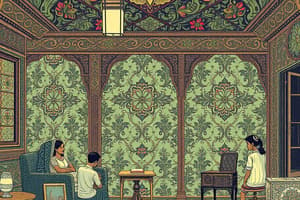Podcast
Questions and Answers
How does the story's setting contribute to its overall meaning?
How does the story's setting contribute to its overall meaning?
- The dilapidated factory setting reinforces the themes of decline and disillusionment within British industry. (correct)
- The setting is used to create a sense of optimism and hope for the future of manufacturing.
- The outdated factory highlights the innovative advancements occurring in British industry.
- The factory setting serves merely as a backdrop without deeper thematic relevance..
Which of the following best captures the contrasting perspectives presented in the story?
Which of the following best captures the contrasting perspectives presented in the story?
- American ambition and innovation versus British tradition and reluctance to change. (correct)
- A celebration of British industrial resilience versus indifference to global markets
- Blind faith in old techniques versus eagerness to adopt modern technology without reservation.
- An emphasis on cooperation versus cutthroat business tactics.
What does the story suggest about the nature of salesmanship in a changing economic environment?
What does the story suggest about the nature of salesmanship in a changing economic environment?
- It's enough to just have modern equipment to guarantee sales.
- Understanding customer needs, persistence, and adaptability are critical. (correct)
- Salesmanship is primarily about manipulation and deceit.
- Salesmanship remains unchanged, regardless of economic shifts.
In the context of the story, what does Foreman's weariness primarily symbolize?
In the context of the story, what does Foreman's weariness primarily symbolize?
How does the author use dialogue to enhance the story's themes and character development?
How does the author use dialogue to enhance the story's themes and character development?
Which of the following best describes the central conflict in 'A.E.C. Out of Business'?
Which of the following best describes the central conflict in 'A.E.C. Out of Business'?
How does Mr. Goolding's character contribute to the theme of modernization in 'A.E.C. Out of Business'?
How does Mr. Goolding's character contribute to the theme of modernization in 'A.E.C. Out of Business'?
Which of these options accurately describes the significance of the 'thread grinder' in the story?
Which of these options accurately describes the significance of the 'thread grinder' in the story?
What primary aspect of Mr. Foreman's character contributes to the story's overall atmosphere of disillusionment?
What primary aspect of Mr. Foreman's character contributes to the story's overall atmosphere of disillusionment?
How does the setting of the story, a dilapidated English factory, contribute to the story's themes?
How does the setting of the story, a dilapidated English factory, contribute to the story's themes?
In 'A.E.C. Out of Business,' what does Mr. Foreman's eventual interest in selling his business to Goolding's American contacts suggest about his state of mind?
In 'A.E.C. Out of Business,' what does Mr. Foreman's eventual interest in selling his business to Goolding's American contacts suggest about his state of mind?
What narrative technique is most evident in the short story 'A.E.C. Out of Business'?
What narrative technique is most evident in the short story 'A.E.C. Out of Business'?
Consider the ending of 'A.E.C. Out of Business'. What feeling is the author trying to evoke from the reader?
Consider the ending of 'A.E.C. Out of Business'. What feeling is the author trying to evoke from the reader?
Flashcards
Generational Differences
Generational Differences
Challenges faced by younger individuals amidst the struggles of a failing industrial environment.
Nature of Salesmanship
Nature of Salesmanship
Persistence, adaptability, and understanding customer needs, even when those needs are unmet.
Symbolism of the Factory
Symbolism of the Factory
Represents the decline of British industry.
Story's Tone
Story's Tone
Signup and view all the flashcards
Factory Setting Symbolism
Factory Setting Symbolism
Signup and view all the flashcards
A.E.C. Out of Business
A.E.C. Out of Business
Signup and view all the flashcards
Mr. Goolding
Mr. Goolding
Signup and view all the flashcards
Mr. Foreman
Mr. Foreman
Signup and view all the flashcards
Decline of British Industry
Decline of British Industry
Signup and view all the flashcards
Disillusionment
Disillusionment
Signup and view all the flashcards
Tenacity vs. Resignation
Tenacity vs. Resignation
Signup and view all the flashcards
Impact of Modernization
Impact of Modernization
Signup and view all the flashcards
Thread Grinder
Thread Grinder
Signup and view all the flashcards
Study Notes
- A.E.C. Out of Business by V. S. Pritchett is a short story delving into themes of disillusionment, the decline of British industry, and the changing social setting through the encounter between a salesman and a struggling business owner.
Plot Summary
- Mr. Goolding, a resilient, aging salesman for an American firm, seeks out Mr. Foreman, the proprietor of a failing English firm.
- Goolding arrives at Foreman's factory hoping to sell equipment, specifically a thread grinder, believing it can help Foreman's business.
- Foreman is a defeated man, burdened by the factory’s decline and past misfortunes, including a troubled son.
- Despite Foreman’s initial disinterest and pessimism, Goolding continues, driven by professional pride and a desire to make a sale in adverse conditions.
- Throughout their interaction, the story shows the dire state of Foreman’s business and deep weariness.
- Goolding eventually gets a flicker of interest from Foreman, not in the thread grinder, but in the possibility of selling his business to Goolding's American contacts.
- The story has no definitive sale, but a sense of Goolding’s tenacity and Foreman’s resignation to the decline of his business remains.
Main Characters
- Mr. Goolding: An experienced, Americanized English salesman, characterized by persistence, adaptability, and a somewhat insensitive optimism, who has an eye for opportunity and is determined to make a sale despite the grim circumstances.
- Mr. Foreman: The owner of a failing English factory, Foreman represents the decline of traditional British industry, and appears world-weary, defeated, and burdened by personal and professional troubles.
Themes
- Decline of British Industry: The story vividly portrays the decline of traditional British manufacturing when faced with American industrial might, in which Foreman’s factory is antiquated, inefficient, and struggling to compete.
- Disillusionment: Both characters display disillusionment, Foreman with his business and life, while Goolding’s relentless salesmanship masks a potential disillusionment with the changing industrial landscape.
- Tenacity vs. Resignation: Goolding demonstrates determination contrasting with Foreman’s resignation to his fate.
- The Impact of Modernization: The narrative explores the impact of American industrial practices on the UK and the sense of displacement felt by those tied to older, less efficient ways of doing business.
- Generational Differences: Foreman’s troubled son, hinted at in the story, suggests a generational gap and the struggles of younger generations within a declining industrial environment.
- The Nature of Salesmanship: The story provides insight into the nature of salesmanship, highlighting the importance of persistence, adaptability, and understanding customer needs (or lack thereof).
Key Points
- The setting is a dilapidated, outdated factory somewhere in England.
- The factory symbolizes the decline of British industry.
- The atmosphere is bleak and reflects Foreman’s pessimism and despair.
Style and Tone
- The story is written in a realistic style with detailed descriptions of the characters and their surroundings.
- The tone is somber and melancholic, reflecting the themes of decline and disillusionment.
- Pritchett uses dialogue effectively to reveal the characters’ personalities and attitudes.
- The prose is precise and evocative, capturing the atmosphere of the factory and the emotional states of the characters.
Symbolism
- The factory symbolizes the decline of British industry and the fading past.
- Goolding’s modern equipment represents the encroachment of American industrial practices.
- Foreman’s weariness symbolizes the burden of the past and the struggle to adapt to change.
Key points
- The story is a commentary on the changing economic landscape and the decline of traditional industries.
- It explores the contrast between American optimism and British resignation.
- The characters are well-developed and represent different aspects of the changing industrial world.
- The setting plays a crucial role in creating the story’s atmosphere and reinforcing its themes.
Studying That Suits You
Use AI to generate personalized quizzes and flashcards to suit your learning preferences.




